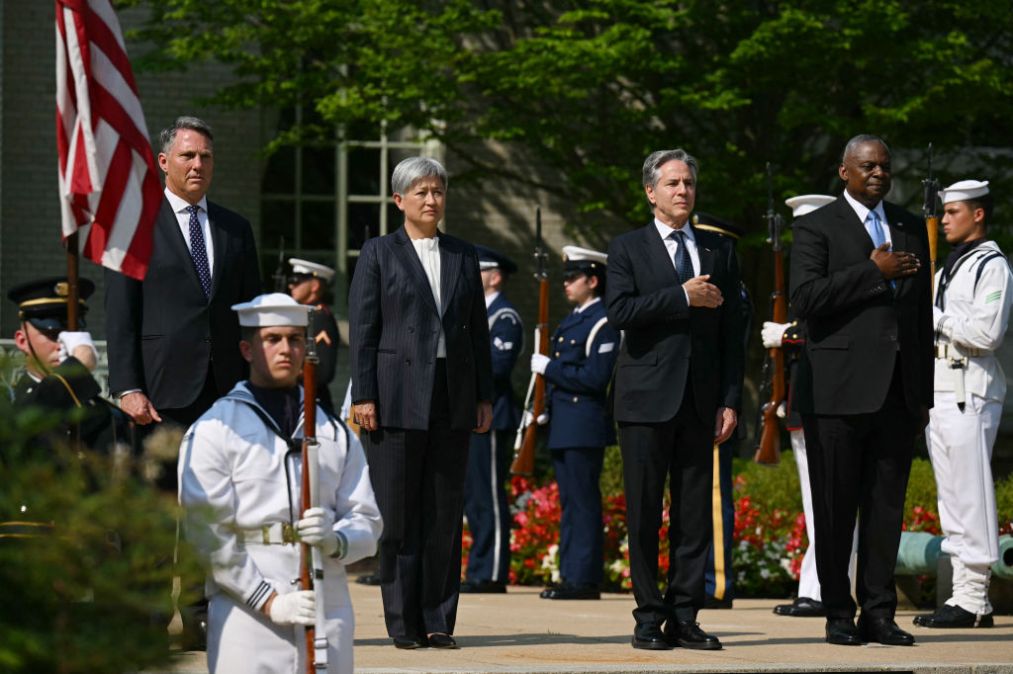US hosts Australia to further deepen military, industrial ties

The U.S. Secretaries of Defense and State are co-hosting their top Australian counterparts this week for ministerial and bilateral meetings where they’re expected to discuss plans for enhanced technology cooperation and shared industrial capacity, according to two senior officials.
These engagements will mark the 34th Australia-United States Ministerial Consultation, or AUSMIN, which is considered a key annual forum for deliberation between the long-standing allies.
During a call with reporters on Monday, two senior defense officials previewed the talks and spotlighted overarching aims to deepen the partnership between Washington and Canberra.
U.S. Secretary of Defense Lloyd Austin was first scheduled to meet bilaterally with Australian Deputy Prime Minister and Minister for Defence Richard Marles at the Pentagon. On Tuesday, they were slated to join their diplomatic counterparts, Secretary of State Antony Blinken and Australian Minister for Foreign Affairs Penny Wong, for the AUSMIN gathering in Annapolis, Maryland, a senior defense official said.
“These engagements will advance the historic progress of the alliance, including on force posture, defense industrial base integration, and collaboration on advanced capabilities,” the official added.
Broadly, the American and Australian militaries have fought together in all major conflicts since World War I — and the two nations’ bilateral defense ties are increasingly and exceptionally close. More recently, they’ve been working together to deter China’s growing influence in the western Pacific region and collaboratively tackle military-related supply chain challenges.
“On defense industrial cooperation, we’re making significant progress with Australia,” a senior defense official told reporters during the call.
“By this December, we will work to conclude an agreement on precision guided missiles, or PrSM, that covers cooperative production, sustainment and follow-on development activities — and we will also establish a joint programs office to advance these activities in 2025 in Huntsville, Alabama,” they confirmed.
Also on the docket for discussion is solidifying the United States’ plan to support Australia’s production of guided multiple launch rocket system missiles (GMLRS).
“The two announcements that we will be making are that we will be pursuing memorandums of understanding for both GMLRS, and then separately for PrSM. Those MOUs will outline the mechanisms for co-production, including the intent to produce viable volumes of GMLRS for global consumption — and then for PrSM, outlining more of our way forward in terms of cooperative production, post-sustainment and follow-on development. So at this time, we don’t have further information to report, but once we have those MOUs negotiated — those will outline kind of our next steps,” a second senior defense official told reporters.
They further hinted at the military partners’ joint plans to integrate new capabilities and test new operational concepts during the next iteration of the Talisman Sabre exercise in 2025 — including amphibious training at Shoalwater Bay.
“We’re also working collaboratively on cutting-edge hypersonic technologies that will provide critical advantage to the warfighter. Australia and the United States are making significant progress in design and ground testing to develop an air-launched hypersonic weapon under the Southern Cross Integrated Flight Research Experiment, or SCIFiRE, which is supporting the bilateral flight test program of the hypersonic attack cruise missile,” the senior defense official said.
The two nations are also aiming to enhance their “force posture cooperation in unprecedented ways,” according to the official.
The militaries are continuing more regular rotations of warfighting platforms, they noted, as well as expanding their logistics cooperation, including by assessing places where the U.S. could locate an enduring logistics support area in Queensland, Australia.
“At AUSMIN, we’ll be announcing new and longer-term operating locations in Australia for force posture cooperation … building upon additional infrastructure upgrades that are already underway at Australia’s northern air bases,” the senior defense official said.
This high-level meetup notably comes on the heels of a 10-day series of engagements that Austin conducted with multiple partners around Asia.
Extending some of those discussions, this week the U.S. and Australia plan to look into ways they can grow cooperative maritime activities together with the Philippines, another American ally which is involved in maritime disputes with China.
Additionally, “we’re fostering greater intelligence, surveillance and reconnaissance, or ISR, cooperation by establishing more trilateral exercises and activities between the United States, Australia and Japan in the Indo-Pacific region,” the senior defense official said.



